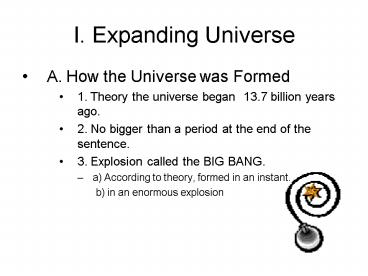I. Expanding Universe - PowerPoint PPT Presentation
1 / 15
Title:
I. Expanding Universe
Description:
... most water and ice-forming material vaporized being so close to the sun ... 4. Planets like Jupiter, Saturn, Uranus and Neptune became very large as well as ... – PowerPoint PPT presentation
Number of Views:116
Avg rating:3.0/5.0
Title: I. Expanding Universe
1
I. Expanding Universe
- A. How the Universe was Formed
- 1. Theory the universe began 13.7 billion years
ago. - 2. No bigger than a period at the end of the
sentence. - 3. Explosion called the BIG BANG.
- a) According to theory, formed in an instant.
- b) in an enormous explosion
2
I. Expanding Universe
- B. cooled as universe expanded.
- 1. if theory correct should find universe still
expanding - 2. Energy still being given off.
- C. Atoms began to form a few hundred thousand
years later - D. 200 million years after that stars and
galaxies began to form - E. Galaxies on the move.
- 1. A Galaxy is a series of star groups
- a). Different kinds of galaxies
- (1)spiral
- (2)elliptical
- (3)irregular galaxies
3
I. Expanding Universe
- b) Spiral have huge spiral arms, we are part of
these - c) Elliptical
- (1)have little dust and gas
- (2)contain older stars
- d) irregular have not order or shape
- e) less common than spiral and elliptical
4
I. Expanding Universe
- 2. Edwin Hubble
- a) Studied the spectrum or energy
- b) Found that he could tell how fast the galaxy
is moving - c) If the galaxy is moving toward our galaxy or
away - d) Found a relationship between the distance to a
galaxy and its speed. - e) Came up with HUBBLES LAW The farther away a
galaxy is, the faster is moving away from us.
This law supports the Big Bang Theory.
5
I. Expanding Universe
- F. Cosmic Background Radiation
- 1. 1965 Arno Penzias and Robert Wilson
accidentally detected faint radiation on a radio
telescope (next slide) - 2. Came from all directions in space.
- 3. Determined to be the leftover thermal energy
from the big bang.
6
(No Transcript)
7
I. Expanding Universe
- G. Universe age
- 1. using cosmic background radiation
- 2. Hubbles Law
- 3. universe is about 13.7 billion years old.
8
II. Formation of the Solar System.
- A. After the big bang, matter separated into
galaxies. - B. Solar Nebula was created
- 1. A giant cloud of gas and dust collapsed to for
our solar system or solar nebula - 2. Gravity pulled the nebula together.
- 3. as it shrank inward spun faster and faster
flattening forming a rotating disk
CONE NEBULA
9
II. Formation of the Solar System.
- 4. most of the gas was pulled into the center
- 5. gas became hot and dense enough for nuclear
fusion to begin - 6. THE SUN WAS BORN!
10
II. Formation of the Solar System.
- C. Planetesimals
- 1. Outer part of spinning disk, gas and dust
formed asteroid-like bodies called Planetesimals. - 2. These created the building blocks for the
planets. - 3. The Planetesimals collided and grew bigger
sticking together eventually forming the planets.
11
II. Formation of the Solar System
- D. Inner Planets
- 1. The solar system was extremely hot when
forming - 2. because of this most water and ice-forming
material vaporized being so close to the sun - 3. Mercury, Venus, Earth, and Mars are all
relatively small and rocky
12
II. Formation of the Solar System
- E. Outer Planets
- 1. further out from the sun, much cooler
- 2. Greater amount of gravity
- 3. planets were able to increase in size because
they were able to obtain the following gasses - a) hydrogen
- b) helium
- 4. Planets like Jupiter, Saturn, Uranus and
Neptune became very large as well as made of gas
and ice
13
The Future of the Universe
- A. One possibly the universe will expand
- 1. will continue to do so
- 2. all stars will burn out
- B. Another possibility is the universe will begin
to move inward - 1. the universe will become cold and dark
- 2. A reverse big bang or big crunch
- 3. all matter will be crushed into an enormous
black hole
14
The Future of the Universe
- A. New observations indicated that the expansion
is more likely to happen. - B. Dark Matter
- 1. makes up about 23 of the universes mass
- 2. can not be seen directly
- 3. can be inferred by observing the effect of its
gravity on visible objects such as stars or light - 4. discovered by Vera Rubin
15
The Future of the Universe
- E. Accelerating Expansion
- 1. late 1990s astronomers observed the expansion
of the universe is expanding faster than it had
in the past. - 2. infer that dark energy is causing this
Today's universe
is expanding at an accelerating rate because
'dark energy' counteracts the force of gravity.
In the early universe matter was closer together,
and gravity still slowed its expansion.































